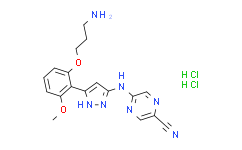| Cas No.: | 1234015-54-3 |
| Chemical Name: | Prexasertib HCl |
| Synonyms: | LY2606368 (dihydrochloride);5-[[5-[2-(3-aminopropoxy)-6-methoxyphenyl]-1H-pyrazol-3-yl]amino]pyrazine-2-carbonitrile,hydrochloride;LY-2606368 dihydrochloride;Prexasertib dihydrochloride |
| SMILES: | NCCCOC(C=CC=C1OC)=C1C2=CC(NC3=NC=C(C#N)N=C3)=NN2.[H]Cl.[H]Cl |
| Formula: | C18H21Cl2N7O2 |
| M.Wt: | 438.31 |
| Sotrage: | 2 years -20°C Powder, 2 weeks 4°C in DMSO, 6 months -80°C in DMSO |
| Description: | Prexasertib dihydrochloride (LY2606368 dihydrochloride) is a potent and selective ATP competitive inhibitor of the Chk1 protein kinase, with IC50s of <1 nM and 8 nM for CHK1 and CHK2, respectively, and a Ki of 0.9 nM against purified CHK1. |
| In Vivo: | Prexasertib (LY2606368; 15 mg/kg, s.c.) significantly inhibits tumor growth in xenograft tumor models with less animal weight loss[1]. Prexasertib (LY2606368; 2 mg/kg, s.c.) and BMN673 combination has synergistic anticancer effect in gastric cancer PDX model, and the effect is higher than that of one drug alone[2]. |
| In Vitro: | Prexasertib (LY2606368) is a potent and selective ATP competitive inhibitor of Chk1, with an IC50 of <1 nM, and also inhibits CHK2, with an IC50 of 8 nM. Prexasertib has an EC50 of 1 nM for CHK1 activity through autophosphorylation of serine 296 and <31 nM for HT-29 CHK2 autophosphorylation (S516). Prexasertib potently abrogates the G2-M checkpoint activated by doxorubicin in p53-deficient HeLa cells with an EC50 of 9 nM. However, 100 nM Prexasertib does not inhibit PMA-stimulated RSK but instead weakly stimulates phosphorylation of S6 on serines 235/236. Prexasertib is broadly antiproliferative with IC50s of 3 nM, 3 nM, 10 nM, 37 nM, and 68 nM against U-2 OS, Calu-6, HT-29, HeLa, and NCI-H460 cell lines, respectively. Prexasertib (4 nM) results in a large shift in cell-cycle populations from G1 and G2-M to S-phase with an accompanied induction of H2AX phosphorylation in U-2 OS cells[1]. Prexasertib (LY2606368; 25 μM) exhibits inhibitory activities against proliferation of AGS and MKN1 cells. Prexasertib (20 nM) inhibits HR repair capacity DR-GFP cells. Prexasertib (5 nM) in combination with PARP inhibitor BMN673, displays synergistic anticancer effects in gastric cancer cells[2]. |

 DC Chemicals' products qualify for U.S. tariff exemptions. We guarantee no price increases due to customs duties and maintain stable supply, continuing to deliver reliable research solutions to our American clients.
DC Chemicals' products qualify for U.S. tariff exemptions. We guarantee no price increases due to customs duties and maintain stable supply, continuing to deliver reliable research solutions to our American clients.





















